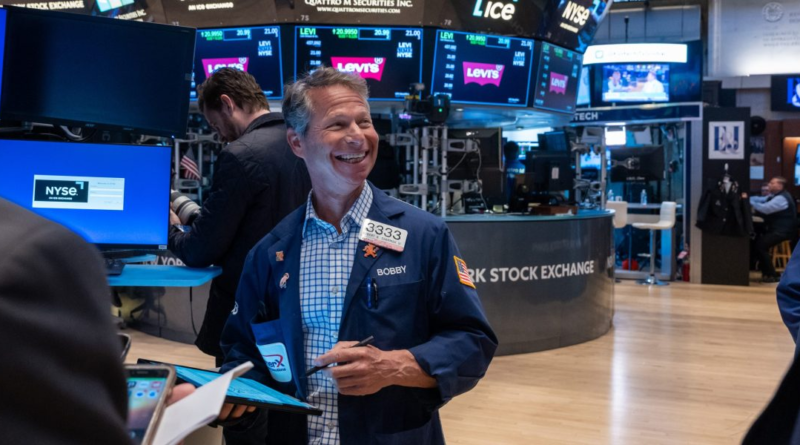The AI-driven rally ‘is not a one-way street,’ but tech earnings should jump 18% this year as demand booms, UBS Global Wealth Management says
Investors’ AI enthusiasm has helped lift technology stocks to new heights this year, both in the U.S. and abroad. The iShares MSCI AC World Information Technology Index, which tracks large- and midcap tech stocks in dozens of developed and developing markets, has surged more than 20% over the past 12 months. And domestically, the vaunted Invesco QQQ Trust Series 1 ETF, which tracks large-cap U.S. tech stocks, is up nearly 40% over the same period.
The run of good form has been so dramatic that even a minor speed bump last week has Wall Street talking. A mere 1% decline in U.S. tech stocks and a 2.1% decline in semiconductor shares led Solita Marcelli, chief investment officer Americas at UBS Global Wealth Management, to remind investors that corrections are natural—“the AI-driven tech rally is not a one-way street.”
The veteran market watcher noted that rising geopolitical tensions and changing forecasts for U.S. interest rate cuts after stronger than expected labor-market data were weighing on tech shares. Still, Marcelli said tech’s very recent underperformance hasn’t changed her positive view of AI-related stocks.
“With robust AI fundamentals, our expectations of 18% year-over-year earnings growth for global tech in 2024, and a reasonable 12-month forward price-to-earnings ratio of around 27x, we stay positive on global tech and companies in the AI value chain in particular,” she wrote in a Monday note.
More demand, more products, and evidence of increasing adoption
Marcelli gave three key reasons for her optimism on AI stocks: the imminent launch of “revolutionary” AI products; evidence of increasing AI adoption; and broadening demand trends.
Ever since OpenAI released its chatbot ChatGPT to the world in November 2022, there’s been a race to release new AI products in the tech sector. Generative AI has enabled the rise of text-to-video platforms like OpenAI’s Sora and text-to-music platforms like Stability AI’s Audio 2.0, but AI is also being used in health care to look for world-changing and potentially lucrative new drugs, and it has numerous new software engineering applications. Marcelli said that the pace of innovation is so strong that she expects “more such breakthrough innovations in the next few quarters” as well.
The potential for new AI products is likely to help broaden demand for the technology. After mostly being led by Big Tech customers last year, Marcelli said there are now “clearer signs of AI demand becoming more ubiquitous.” She highlighted sovereign entities including Sweden, Singapore, Japan, Korea, and more as key sources of incremental demand.
Erika Klauer, a technology equity portfolio manager at Jennison Associates, an investment management firm with $194 billion in assets under management, shared a similar view. She previously explained to Fortune that governments around the world essentially want “their own version of ChatGPT, with training on their own languages … their own archives, their own cultural nuances,” and that means a lot of new spending for AI companies to take advantage of.
To her point, the billionaire chairman and chief technology officer of Oracle, Larry Ellison, revealed that his company is negotiating with several countries and sovereign regions to run government applications on the cloud, including AI. “Pretty much every government is going to want a sovereign cloud,” Ellison said on a recent earnings call.
As far as evidence of AI adoption, UBS’s Marcelli pointed to recent surveys that show a rising percentage of companies using AI. While only 5.4% of U.S. companies were using AI as of the first quarter, according to the U.S. Census Bureau’s Business Trends and Outlook Survey, that’s still well above the 3.7% figure from the third quarter of 2023. And Marcelli predicted that this share could rise to between 6.6% and 12% over the next six months.
She also noted that AI adoption rates are much higher in the tech sector. In the Census Bureau’s information sector (NAICS 51), for example, 18% of companies said they used AI to produce goods or services in the first quarter. “We remain positive on the broader AI theme,” Marcelli concluded.
The big threat: A hawkish Fed
While AI-related companies still have some tailwinds, there is a big threat on the horizon. Just months ago, investors were certain that the Federal Reserve would be cutting interest rates this summer. The potential for lower borrowing costs helped the stock market outperform this year, but multiple hotter-than-expected inflation reports and some surprisingly strong labor market data recently have led experts to fear that the Fed won’t be cutting rates anytime soon. As Richard Saperstein, chief investment officer at Treasury Partners, told Fortune: “With low unemployment, economic strength, and inflation above the Fed’s 2% target, it’s unlikely we’ll see any rate cuts before July.”
If that turns out to be the case, tech stocks, which are seen as higher-risk assets and thus typically face pressure when rates rise, could suffer a pullback. And Saperstein warned that “with stock valuations near record highs, the burden is on earnings to drive further rises in stock prices.”
“Given the elevated market multiples and rising bond yields, we remain cautious on stocks until earnings season delivers clear evidence of earnings growth,” he added.



